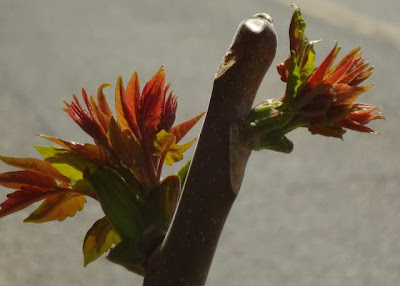
Weather: Last useful precipitation 4/9/12; 13:34 hours of daylight today.
The early warm period has turned into an ideal time for planting, because the afternoons are still clouding over and moisture is in the air, unlike how it will be in June. The only problem is the occasional spate of high winds like those Thursday afternoon.
What’s blooming in the area: Apples, Austrian Copper, Persian yellow and hybrid roses, forsythia, wisteria, bearded iris, yucca, moss phlox, donkey tail spurge, blue perennial salvia.
Grapes are leafing; this year they waited until after the last cold day, and so weren’t set back like they were last year.
Beyond the walls and fences: Cottonwood, tamarix, fernleaf globemallow, western stickseed, bractless cryptantha, alfilerillo, hoary cress, purple and tansy mustards, purple mat flower, gypsum phacelia, antelope horns, blue gilia, running sand verbena, bindweed, oxalis, goat’s beard, common and native dandelion, June and cheat grasses; buds on Apache plume, cream tips, rice and needle grasses.
Elm seeds are accumulating everywhere.
Large flowered white evening primroses are blooming for the first time since the primrose beetle invasion of 2003.
In my yard: Spirea, lilacs, Siberian pea, tulip, baby blue iris, Bath pinks, snow-in-summer, vinca, yellow alyssum, blue flax; buds on beauty bush, snowball, Jupiter’s beard, coral bells.
New buds are appearing on my catalpa; only one branch seems to have nothing.
Reseeded cosmos seeds are putting out second leaves.
Bedding plants: Pansies, sweet alyssum, petunia.
What’s blooming inside: Zonal geranium, pomegranate.
Animal sightings: Chickadees, gecko, harvester and small black ants.
Feeding the local homeless cat has done nothing to discourage the chickadees from breaking into my soffit to nest. I’d rather hoped they’d do a better job of reconnoitering the neighborhood. I started putting out food last summer to stop the cat from lurking under their nest, and hoped, in return, the birds would finally abandon my house.
Weekly update: Spring sees a somewhat orderly succession of plant families, under the general dominance of the roses. Now it’s the borages turn to flower.
The first to arrive was western stickseed, which began germinating in my driveway in early March, and was blooming by mid April.

Because of the warm weather, cool nights, and not quite dehydrating air, the stems are now six to eight inches tall and haven’t started producing seeds.

The next to appear was bractless cyrptantha, which began blooming a few days later than stickseed. Normally, it remains close to the ground

but again, because of the unusual spring, its stems have begun to elongate.

Now there’s a plant blooming I don’t know, but recognize. I’ve been watching it for several years growing in sandy areas of the far arroyo and its banks, but haven’t found it in any of my wildflower field guides. It started producing five petaled white flowers a week ago, on small furry plants like the already blooming members of the borage family.

This week, the stems for the heads have extended, both in the supporting member and within the cluster, so it begins to resemble a mounded phlox.

Soon the florets will brown

And look like the plant has died, much like the annual stickseed and cryptantha which will disappear.

However, come late summer, new leaves will appear

which will persist into winter. Then, some of those winter kill, and new ones emerge, until the cycle repeats itself.

I haven’t yet noticed when seeds germinate, but I’m guessing it was in the weeks just before the flowers appeared. There are more plants out there than I remember this winter.
As for its identity, tiny plants with limited blooming periods are easily overlooked by wildflower enthusiasts, and so are omitted from popular guide books. The number of petals, their color, the hairiness of the leaves is not enough for a botanist to classify a plant, but they are enough for me to give it a label.
If anyone knows what this little flower is, please let me know.
Notes: For more on western stickseed, see entry for 9 December 2007; for bractless cryptantha, see entry for 9 May 2010.
Vicki suggested my borage is the bow-nut cryptantha (Cryptantha jamesii) shown on Gene Jercinovic’s Flowers of the Manzanos web site. When I went to look for it, I found it more closely resembled the tawny cryptantha (Cryptantha fulvocanescens) on Al Schneider’s South West Colorado Wildflowers web site. I never would have found this without Vicki’s assistance. Thanks for the help. As for which species it is, Schneider said it’s nearly impossible to tell one cryptantha from another without a microscope to examine the seeds.
Photographs:
1. Unknown plant, 27 April, 2012, along the bank of the ranch road.
2. Western stickseed, 4 March 2012, growing in my drive in one of its favorite places, the top of a harvester ant hill.
3. Western stickseed, 14 April 2012, on the shoulder of the orchard road.
4. Bractless cryptantha, 18 April 2012, on the prairie.
5. Bractless cryptantha, 19 April 2012, along the bank of the ranch road.
6. Unknown plant, 19 April 2012, far arroyo bottom.
7. Unknown plant colony, 27 April 2012, along the base of the far arroyo left bank.
8. Unknown plant, 23 May 2010, on the prairie.
9. Unknown plant, 27 June 2010, on the prairie.
10. Unknown plant, 28 November 2011, on the prairie.
11. Unknown plant, 18 April 2012, on the prairie.
12. Unknown plant, 27 April 2012.







































